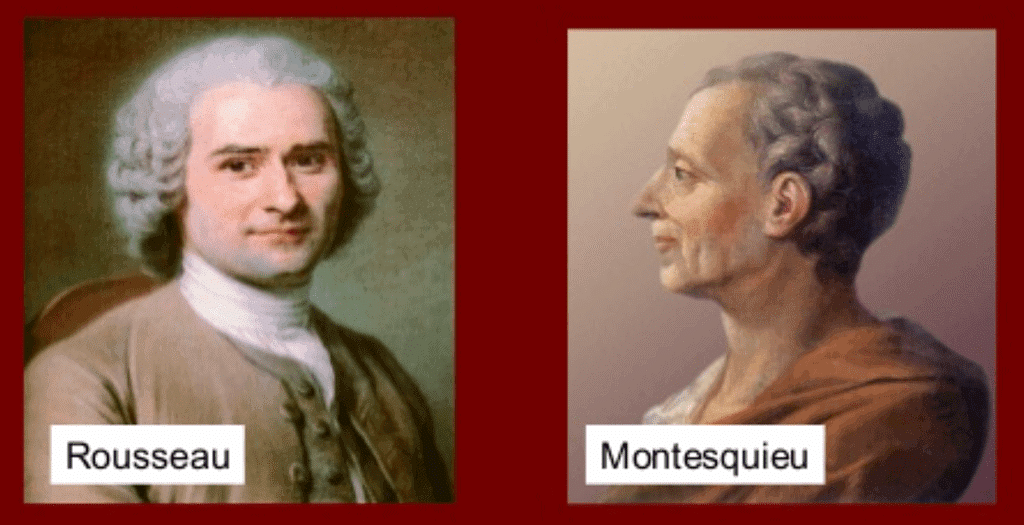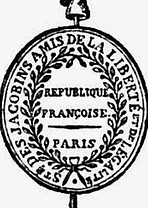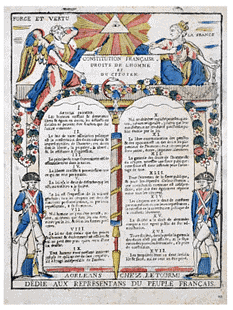Class 9 History Chapter 1 Question Answers - The French Revolution
Q51. In what circumstances did the French Revolution occur?
Or
Discuss the political, economic, and social causes of the French Revolution.
Ans: Following were the reason for the French Revolution: French Revolution
French Revolution
- Social: The social conditions in France in the late 18th century were extremely unequal and exploitative. The clergy and the nobility formed the first two Estates and were the most privileged classes in French society. The Third Estate that consisted of peasants and workers, formed the majority of the population. They were burdened with excessive taxes with no political and social rights. As a result, they were extremely discontent.
- Economic: As a result of numerous wars waged by Louis XVI, the State coffers were empty. The situation was made even more complex by France’s involvement in the American War of Independence and the faulty system of taxation. While the privileged classes were excused from paying taxes, the Third Estate was more and more burdened with them.
- Political: The Bourbon king of France, Louis XVI, was an extremely autocratic and weak-willed king who led a life of obscene luxury. This led to a lot of disenchantment among the masses who then were leading life of extreme poverty and widespread hunger.
Q52. ‘The French philosophers of the 18th century greatly influenced the people and it led to the French Revolution.’ Comment on this statement.
Ans: Philosophers such as Montesquieu and Rousseau put forward ideas envisaging a society based on freedom and equal laws and opportunities for all. In his Two Treatises of Government, John Locke sought to refute the doctrine of the divine and absolute right of the monarch.

Rousseau carried the idea forward, proposing a form of government based on 'social contract' between people and their representatives. In the spirit of the laws, Montesquieu proposed a division of power within the government between the legislature, the executive, and the judiciary. This form of government was put into force in the USA. It was an important example for political thinkers in France.
Q53. Explain the importance of the following events on the course of the French Revolution:
(a) Storming of the Bastille
(b) March on the Versailles by the women of Paris
(c) The passing of the Civil Constitution of the clergy
Ans:
(a) On July 14, 1789, a mob of Paris stormed the fortress – the prison of Bastille – considered a symbol of oppression and despotism. The Swiss guards were killed and prisoners set free. The mob stole arms and ammunition. To this day, France celebrates Bastille Day’ on 14th July every year.
 The Storming of the Bastille
The Storming of the Bastille
(b) The march on the Versailles by women of Paris signified the fact that women became active participants in the French Revolution. They gained equal status in society. The slogans of liberty, equality, and fraternity became true.
(c) In 1790, the Civil Constitution nationalised the church. The clergy or group of persons who enjoyed special powers in the church were also forced to relinquish power. Tithes were abolished and lands owned by the church were confiscated.
Q54. Describe the Reign of Terror and the role played by Robespierre in it.
Ans: The period from 1793 to 1794 is referred to as the Reign of Terror. Maximilian Robespierre, leader of the Jacobins, followed the policy of severe control and punishment. All those he saw as enemies of the Republic — ex-nobles, clergy, political opponents — were arrested, tried, and guillotined if found guilty.
 Reign of Terror
Reign of Terror
He issued laws placing a maximum ceiling on wages and prices. Meat and bread were rationed. The use of expensive white flour was forbidden. Robespierre followed his policies so relentlessly that even his supporters began to demand moderation. Finally, he was convicted, arrested, and guillotined in July 1794.
Q55. What is the legacy left by the French Revolution?
Ans: The ideas of liberty Equality (democratic rights) and Fraternity were the most important legacy of the French Revolution. These spread from France to the rest of Europe during the nineteenth century, where feudal systems were abolished.
Colonised people reworked the idea of freedom from bondage into their movements to create a sovereign state. Tipu Sultan and Ram Mohan Roy are two examples of individuals who responded to the ideas coming from revolutionary France.
Q56. What did the following symbols convey in the Declaration of Rights?
(i) The broken chain
(ii) The bundle of rods or fasces
(iii) The eye within a triangle radiating light
(iv) Sceptre
(v) Snake biting its tail to form a ring
(vi) Red Phrygian cap
(vii) Blue-White-Red
(viii) The winged woman
(ix) The law tablet
Ans:
(i) The broken chain: Chains were used to fetter slaves. A broken chain stands for the act of becoming free.
(ii) The bundle of rods or fasces: One rod can be easily broken, but not an entire bundle. Strength lies in unity.
(iii) The eye within a triangle radiating light: The all-seeing eye stands for knowledge. The rays of the sun will drive away from the clouds of ignorance.
(iv) Sceptre: Symbol of royal power.
(v) Snake biting its tail to form a ring: Symbol of eternity. A ring has neither beginning nor end.
(vi) Red Phrygian cap: Cap is worn by a slave upon becoming free.
(vii) Blue-white-red: The national colours of France.
(viii) The winged woman: Personification of the law.
(ix) The law tablet: The law is the same for all, and all are equal before it.
Q57. Who were the Jacobins? What was their contribution to the French Revolution?
Ans: The most successful of political clubs was that of the Jacobins. They got their name from the former convent of St. Jacob in Paris. They included small shopkeepers, artisans such as shoemakers, pastry cooks, watch-makers, printers, as well as servants, and daily wage earners. Their leader was Maximilian Robespierre. Seal of the Ja-cobian Club (1792-1794)
Seal of the Ja-cobian Club (1792-1794)
Contribution: In the summer of 1792, they planned an insurrection of a large number of Parisians who were angered by the short supplies and high prices of food. On August 10, they stormed the Palace of the Tuileries, massacred the king's guards, and imprisoned the king. Elections were now held.
The newly elected assembly was called the Convention. On 21st September 1792, it abolished the monarchy and declared France a republic. Louis XVI was sentenced to death by a court on the charge of treason and executed on 21st January 1793. The queen also met with the same fate.
Q58. Discuss the participation of women in political clubs, their activities, and demands.
Ans:
(i) In order to discuss and voice their interests, women started their own political clubs and newspapers. About sixty women’s clubs came up in different French cities.
 Women in Political Clubs(ii) The Society of Revolutionary and Republican Women was the most famous of them. One of their main demands was that women should be given the same political rights as men.
Women in Political Clubs(ii) The Society of Revolutionary and Republican Women was the most famous of them. One of their main demands was that women should be given the same political rights as men.
(iii) Women were disappointed that the constitution of 1791 reduced them to passive citizens. They demanded the right to vote, to be elected to the Assembly and to hold political office.
(iv) Women’s struggle for equal political rights, however, continued. It was finally in 1946 that women in France won the right to vote.Q59. “The revolutionary government took it upon themselves to pass laws that would translate the ideals of liberty and equality into everyday practice.”Q.59. Discuss this statement with special emphasis on the abolition of censorship.
- One important law that came into effect soon after the storming of the Bastille in the summer of 1789 was the abolition of censorship. Earlier all written material and cultural activities — books, newspapers, plays — could be published or performed only after the censors had approved them of the king.
- Now the Declaration of the Rights of Man and Citizen declared freedom of speech and expression to be a natural right. They all described and discussed the events and changes taking place in France. Freedom of the press also meant that opposing views of events could be expressed. Each side sought to convince the others of its position through the medium of print.
- Plays, songs, and festive processions attracted large numbers of people. This was one way they could grasp and identify with ideas such as liberty or justice that political philosophers wrote about at length in texts. Newspapers, pamphlets, books, and printed pictures flooded the towns of France from where they traveled rapidly into the countryside.
Q60. Describe any four causes for the fall of the Jacobin government in France.
Ans: The causes for the fall of the Jacobin government in France are as follows:
(i) The Jacobin government in France was based on extreme measures. The period from 1793- 1794 is referred to as the reign of terror. Robespierre followed a policy of severe control and punishment. This led to chaos and resentment among the people.
(ii) The Jacobin government issued laws placing a maximum ceiling on wages and prices. Meat and bread were rationed. Peasants were forced to transport their grain to the cities and sell it at prices fixed by the government. This led to a feeling of resentment against the Jacobins. Peasants began opposing them.
(iii) Robespierre’s government ordered shutting down of churches and converting church buildings into barricades or offices. Thus the clergy turned against the Jacobin regime and hastened its fall.
(iv) Robespierre pursued his policies so relentlessly that even his supporters turned against him. They began to demand moderation and a middle path. Finally, he himself was tried by a court in July 1794, arrested, and guillotined.
Q61. State the election process of the National Assembly in France.
Ans: The constitution of 1791 vested the power to make laws in the National Assembly, which was indirectly elected. Citizens voted for a group of electors, who in turn close the assembly. All citizens did not have the right to vote.
Only men above 25 years of age who paid taxes equal to at least 3 days of a labourer's wage were given the status of active citizens, that is, they were entitled to vote. The remaining men and all women were classed as passive citizens. To qualify as an elector and then as a member of the assembly, a man had to belong to the highest bracket of taxpayers.
Q62. What changes were brought in France after the fall of Robespierre's government? How did it lead to the rise of Napoleon Bonaparte?
Ans: The changes are as follows:
(i) The fall of Robespierre's government led to the seizure of power by the wealthier middle classes.
(ii) A new constitution was introduced, which denied the vote to non-propertied sections of society.
(iii) It provided for two elected legislative councils. These then appointed a Directory, an executive made up of five members.
(iv) This was to check the concentration of powers in the hands of a one-man executive which could turn tyrannical.
(v) But the directors often clashed with the legislative councils, who then sought to dismiss them. The political instability of the Directory paved the way for the rise of the military dictator Napoleon Bonaparte.
Q63. Describe the importance of the Declaration of the Right of Man in France.
Ans: The Declaration of the Right of Man in France was a landmark decision in the history of France. The constitution began with a declaration of the Rights of Man and Citizen.
- Rights such as the right to life, freedom of speech, freedom of opinion, equality before the law, were established as ‘natural and 'inalienable' rights.
- That is, they belonged to each human being by birth and could not be taken away.
- It was the duty of the state to protect each citizen's natural rights.
- The declaration of the Right of Man and Citizens influenced revolutionary movements elsewhere too.
 Declaration of the Rights of Man
Declaration of the Rights of Man
Q64. What landmark decisions were taken by the National Assembly led by the Third Estate on 4th August 1789?
Ans: On 4 August 1789, the Assembly passed a decree abolishing the federal system of obligations and taxes. Members of the clergy too were forced to give up their privileges. Tithes were abolished and lands owned by the church were confiscated. As a result, the government acquired assets worth at least 2 billion livres.
|
53 videos|437 docs|80 tests
|
FAQs on Class 9 History Chapter 1 Question Answers - The French Revolution
| 1. What were the causes of the French Revolution? |  |
| 2. How did the French Revolution change France? |  |
| 3. What was the Reign of Terror in the French Revolution? |  |
| 4. Who were the key figures in the French Revolution? |  |
| 5. What impact did the French Revolution have on the rest of Europe? |  |

|
Explore Courses for Class 9 exam
|

|













